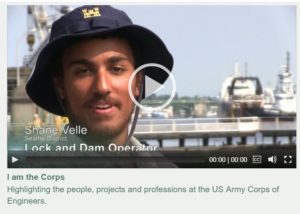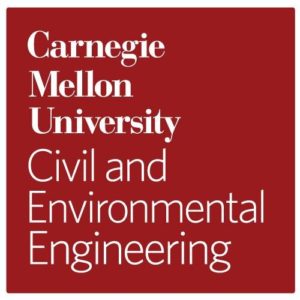 Fifteen students from Cardinal Wuerl North Catholic got the incredible opportunity to travel around the Pittsburgh area and learn first-hand about sustainability and engineering. We heard from many great minds in the fields of engineering and conservation. I was one of these students, and the whole day was eye-opening and I learned an incredible amount of important information. One of our stops involved going to Carnegie Mellon University in North Oakland to learn about what CMU does to be sustainable. Another purpose was to be educated on their engineering major, and how that class involves a lot of environmental engineering and learning about sustainable engineering.
Fifteen students from Cardinal Wuerl North Catholic got the incredible opportunity to travel around the Pittsburgh area and learn first-hand about sustainability and engineering. We heard from many great minds in the fields of engineering and conservation. I was one of these students, and the whole day was eye-opening and I learned an incredible amount of important information. One of our stops involved going to Carnegie Mellon University in North Oakland to learn about what CMU does to be sustainable. Another purpose was to be educated on their engineering major, and how that class involves a lot of environmental engineering and learning about sustainable engineering.
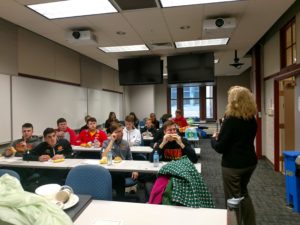 First, we heard from Gwen Dipietro, the instructor of Introduction to Sustainable Engineering at Carnegie Mellon. She talked about her course and what the experiments her students due to preserve biodiversity and remain sustainability. She also talked about her research she completed in Pittsburgh. She researched the tugboats that move coal through the locks and dams of Pittsburgh. Her goal was to see how much coal went through these locks and dams as well as how often these transports occurred. Her teaching assistant, Genna Waldvogel, also spoke about her life as an engineer and how sustainability plays a large part in it. She discussed her research project to get her Masters Degree in Civil and Environmental Engineering. It involved the chemicals in the rivers of Pittsburgh and their possible toxicity. These instructors are great examples of sustainability in engineering and making a choice to try to be as sustainable as possible.
First, we heard from Gwen Dipietro, the instructor of Introduction to Sustainable Engineering at Carnegie Mellon. She talked about her course and what the experiments her students due to preserve biodiversity and remain sustainability. She also talked about her research she completed in Pittsburgh. She researched the tugboats that move coal through the locks and dams of Pittsburgh. Her goal was to see how much coal went through these locks and dams as well as how often these transports occurred. Her teaching assistant, Genna Waldvogel, also spoke about her life as an engineer and how sustainability plays a large part in it. She discussed her research project to get her Masters Degree in Civil and Environmental Engineering. It involved the chemicals in the rivers of Pittsburgh and their possible toxicity. These instructors are great examples of sustainability in engineering and making a choice to try to be as sustainable as possible.
Next, Ron Ripper spoke to us about the sustainable practices that Carnegie Mellon practices. Ron Ripper is the Director of the Hauck Laboratories in Civil and Environmental Engineering. He spoke about how CMU composts and recycles, and the benefits to that. Carnegie Mellon has taken many steps to become more sustainable like paper utensils, wood coffee stirrers, and avoiding styrofoam. Although the benefits are easy to see, the cost of paper utensils is much higher and recycling and composting are time-consuming. This shows how dedicated CMU is to helping the environment and preserving our planet.
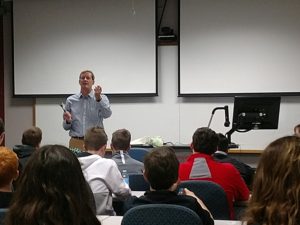 Andrea Rooney, the director of undergraduate programs in the department then spoke. She talked about a variety of topics, one of which being a project that her classes completed. It was all about exploring where each part of a product came from. She used the example of a water bottle and spoke about how the cap, wrapper and, even the ink all come from different places, increasing the carbon footprint needed to make the bottle. In her study, it was found that about six times the amount of water in a water bottle is needed to produce that water bottle. It was very interesting to hear all the seemingly nonexistent things that go into making a water bottle.
Andrea Rooney, the director of undergraduate programs in the department then spoke. She talked about a variety of topics, one of which being a project that her classes completed. It was all about exploring where each part of a product came from. She used the example of a water bottle and spoke about how the cap, wrapper and, even the ink all come from different places, increasing the carbon footprint needed to make the bottle. In her study, it was found that about six times the amount of water in a water bottle is needed to produce that water bottle. It was very interesting to hear all the seemingly nonexistent things that go into making a water bottle.
Finally, we watched a video featuring many of the students in the Civil Engineering Program at Carnegie Mellon University. They talked about their education and the hands-on learning that they get to do on a daily basis. It was very cool to see that all of these students genuinely enjoyed what they were doing. Overall, I learned so much about sustainability and conservation from these great engineering minds. They made me appreciate the little things that get overlooked all the time and realize that everyone can make a difference by doing small things.
 On November 17, The Students of Mrs. Steiniger’s Biology class from Cardinal Wuerl North Catholic arrived at the brand new Pittsburgh office of Bohler Engineering for a STEM Career tour all about sustainability. Bohler has been consulting on land development projects for a few decades now, and while not always demanded, they do consistently attempt to add as many green touches as possible to their projects.
On November 17, The Students of Mrs. Steiniger’s Biology class from Cardinal Wuerl North Catholic arrived at the brand new Pittsburgh office of Bohler Engineering for a STEM Career tour all about sustainability. Bohler has been consulting on land development projects for a few decades now, and while not always demanded, they do consistently attempt to add as many green touches as possible to their projects.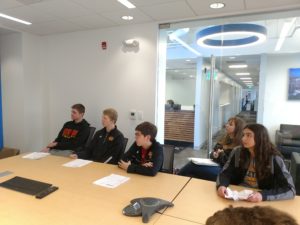 Mr. Takacs was also able to share knowledge of other sustainable projects of note and interest within the city, including a recently constructed building that can be opened up and cooled passively with natural air currents.
Mr. Takacs was also able to share knowledge of other sustainable projects of note and interest within the city, including a recently constructed building that can be opened up and cooled passively with natural air currents.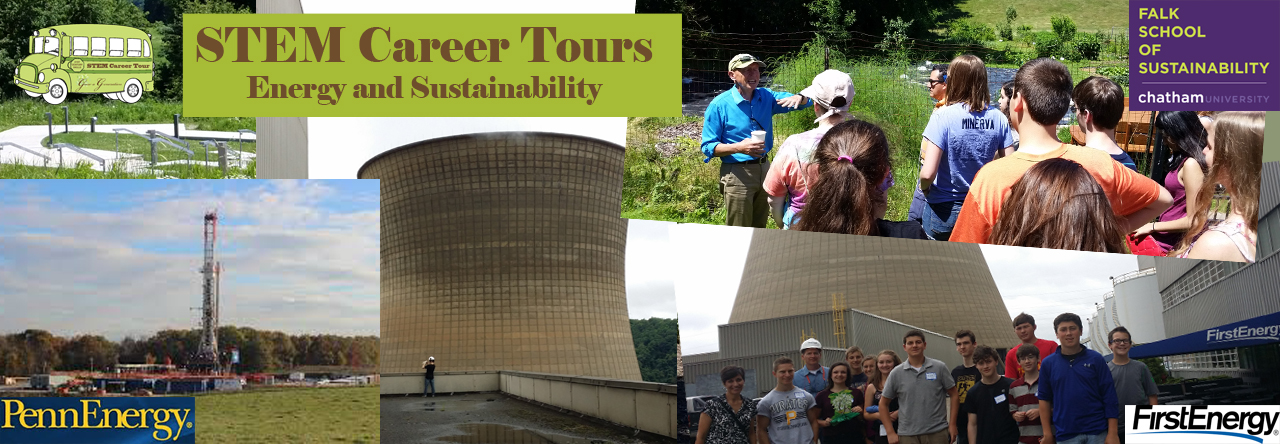
 ovember 17th Mrs. Steiniger’s Biology class from Cardinal Wuerl North Catholic High School toured the Center For Sustainable Landscapes at Phipps Conservatory, as part of Sustainability Stem Career Tour. The Center For Sustainable Landscapes is one of the greenest buildings in the world, meeting the requirements of the Living Building Challenge the strictest classification for a green building project.
ovember 17th Mrs. Steiniger’s Biology class from Cardinal Wuerl North Catholic High School toured the Center For Sustainable Landscapes at Phipps Conservatory, as part of Sustainability Stem Career Tour. The Center For Sustainable Landscapes is one of the greenest buildings in the world, meeting the requirements of the Living Building Challenge the strictest classification for a green building project.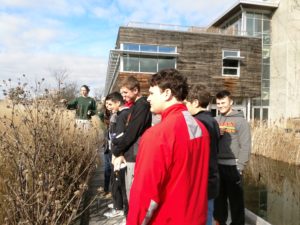
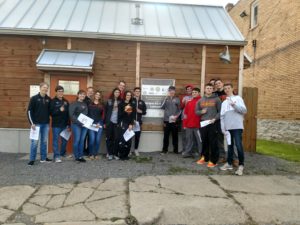 My name is Tim Roos, I’m a sophomore at North Catholic, and I recently went on the sustainability field trip at North. On the field trip, we stopped at the Oasis Farm Fishery in Homewood. The main topic of the tour as sustainability, and how Oasis has incorporated it into its function. Homewood is what is considered a food desert, which is an area that has no access to fresh fruits or vegetables.
My name is Tim Roos, I’m a sophomore at North Catholic, and I recently went on the sustainability field trip at North. On the field trip, we stopped at the Oasis Farm Fishery in Homewood. The main topic of the tour as sustainability, and how Oasis has incorporated it into its function. Homewood is what is considered a food desert, which is an area that has no access to fresh fruits or vegetables.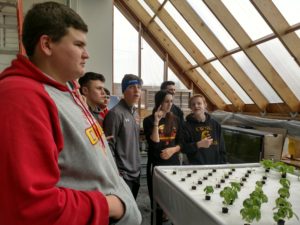 ed sustainable agricultural practices such as aquaponics, but I know so much more now that I went to Oasis Farm Fishery. For instance, I didn’t know that you want the roots of plants to be white, which shows that there is a good amount of oxygen present. Oasis Fishery is using the most with what they’ve got. If the temperature becomes too hot in the greenhouse, they cover the sides with a metal-mesh cover, that reflects 50% of the sunlight and warmth, so the vegetables don’t fry to death. Every so often insects enter the greenhouse and eat away at the crops. Once Casey notices the insect problem, he will introduce a predator to the greenhouse. For example, if aphids are the problem, he would introduce ladybugs.
ed sustainable agricultural practices such as aquaponics, but I know so much more now that I went to Oasis Farm Fishery. For instance, I didn’t know that you want the roots of plants to be white, which shows that there is a good amount of oxygen present. Oasis Fishery is using the most with what they’ve got. If the temperature becomes too hot in the greenhouse, they cover the sides with a metal-mesh cover, that reflects 50% of the sunlight and warmth, so the vegetables don’t fry to death. Every so often insects enter the greenhouse and eat away at the crops. Once Casey notices the insect problem, he will introduce a predator to the greenhouse. For example, if aphids are the problem, he would introduce ladybugs. Fifteen students from Cardinal Wuerl North Catholic got the incredible opportunity to travel around the Pittsburgh area and learn first-hand about sustainability and engineering. We heard from many great minds in the fields of engineering and conservation. I was one of these students, and the whole day was eye-opening and I learned an incredible amount of important information. One of our stops involved going to Carnegie Mellon University in North Oakland to learn about what CMU does to be sustainable. Another purpose was to be educated on their engineering major, and how that class involves a lot of environmental engineering and learning about sustainable engineering.
Fifteen students from Cardinal Wuerl North Catholic got the incredible opportunity to travel around the Pittsburgh area and learn first-hand about sustainability and engineering. We heard from many great minds in the fields of engineering and conservation. I was one of these students, and the whole day was eye-opening and I learned an incredible amount of important information. One of our stops involved going to Carnegie Mellon University in North Oakland to learn about what CMU does to be sustainable. Another purpose was to be educated on their engineering major, and how that class involves a lot of environmental engineering and learning about sustainable engineering. First, we heard from Gwen Dipietro, the instructor of Introduction to Sustainable Engineering at Carnegie Mellon. She talked about her course and what the experiments her students due to preserve biodiversity and remain sustainability. She also talked about her research she completed in Pittsburgh. She researched the tugboats that move coal through the locks and dams of Pittsburgh. Her goal was to see how much coal went through these locks and dams as well as how often these transports occurred. Her teaching assistant, Genna Waldvogel, also spoke about her life as an engineer and how sustainability plays a large part in it. She discussed her research project to get her Masters Degree in Civil and Environmental Engineering. It involved the chemicals in the rivers of Pittsburgh and their possible toxicity. These instructors are great examples of sustainability in engineering and making a choice to try to be as sustainable as possible.
First, we heard from Gwen Dipietro, the instructor of Introduction to Sustainable Engineering at Carnegie Mellon. She talked about her course and what the experiments her students due to preserve biodiversity and remain sustainability. She also talked about her research she completed in Pittsburgh. She researched the tugboats that move coal through the locks and dams of Pittsburgh. Her goal was to see how much coal went through these locks and dams as well as how often these transports occurred. Her teaching assistant, Genna Waldvogel, also spoke about her life as an engineer and how sustainability plays a large part in it. She discussed her research project to get her Masters Degree in Civil and Environmental Engineering. It involved the chemicals in the rivers of Pittsburgh and their possible toxicity. These instructors are great examples of sustainability in engineering and making a choice to try to be as sustainable as possible. Andrea Rooney, the director of undergraduate programs in the department then spoke. She talked about a variety of topics, one of which being a project that her classes completed. It was all about exploring where each part of a product came from. She used the example of a water bottle and spoke about how the cap, wrapper and, even the ink all come from different places, increasing the carbon footprint needed to make the bottle. In her study, it was found that about six times the amount of water in a water bottle is needed to produce that water bottle. It was very interesting to hear all the seemingly nonexistent things that go into making a water bottle.
Andrea Rooney, the director of undergraduate programs in the department then spoke. She talked about a variety of topics, one of which being a project that her classes completed. It was all about exploring where each part of a product came from. She used the example of a water bottle and spoke about how the cap, wrapper and, even the ink all come from different places, increasing the carbon footprint needed to make the bottle. In her study, it was found that about six times the amount of water in a water bottle is needed to produce that water bottle. It was very interesting to hear all the seemingly nonexistent things that go into making a water bottle.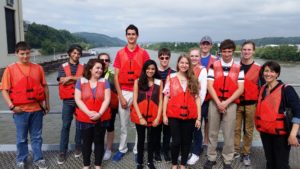 The last day of the 2016 STEM Careers Tour began with a visit to the Emsworth Locks and Dams which is operated by the U.S. Army Corp of Engineers. It is one of six major river facilities on the Ohio River in the Pittsburgh Engineering District located near the towns of Emsworth, Avalon and Ben Avon, Pennsylvania, 6.2 miles below Pittsburgh. It was built in 1919 at a cost of $5.8 million and has undergone several renovations. Today it averages about 470 commercial lockages every month and about 375 additional lockages of pleasure crafts during the summer months.
The last day of the 2016 STEM Careers Tour began with a visit to the Emsworth Locks and Dams which is operated by the U.S. Army Corp of Engineers. It is one of six major river facilities on the Ohio River in the Pittsburgh Engineering District located near the towns of Emsworth, Avalon and Ben Avon, Pennsylvania, 6.2 miles below Pittsburgh. It was built in 1919 at a cost of $5.8 million and has undergone several renovations. Today it averages about 470 commercial lockages every month and about 375 additional lockages of pleasure crafts during the summer months.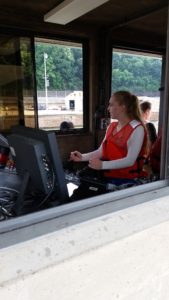 When we arrived for our tour, we were outfitted with life jackets, and began the walk over to the lock system. We were fortunate to see a commercial barge in the lock chamber waiting for the water to rise, so it could continue its journey upstream. As the vessel waited in the chamber, valves gradually let water into the chamber from the upper pool behind the dam through culverts in the lock wall. It usually takes about an hour for the water level to reach the desired height. A boat usually waits about an hour for the water levels to reach equilibrium. No pumping is necessary since the water moves by gravity. Once the water reached the same level on both sides of the gates, one set of gates was opened to let out the boat. Our guide let the students operate the controls and open the lock gates. So cool!
When we arrived for our tour, we were outfitted with life jackets, and began the walk over to the lock system. We were fortunate to see a commercial barge in the lock chamber waiting for the water to rise, so it could continue its journey upstream. As the vessel waited in the chamber, valves gradually let water into the chamber from the upper pool behind the dam through culverts in the lock wall. It usually takes about an hour for the water level to reach the desired height. A boat usually waits about an hour for the water levels to reach equilibrium. No pumping is necessary since the water moves by gravity. Once the water reached the same level on both sides of the gates, one set of gates was opened to let out the boat. Our guide let the students operate the controls and open the lock gates. So cool!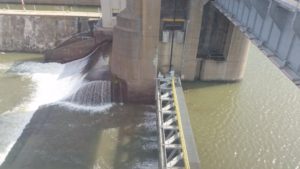 Touring the Emsworth Locks and Dams was definitely a highlight of the 2016 STEM Careers Tour. We were so fortunate to have a beautiful to tour and arrive during a lockage!
Touring the Emsworth Locks and Dams was definitely a highlight of the 2016 STEM Careers Tour. We were so fortunate to have a beautiful to tour and arrive during a lockage!
